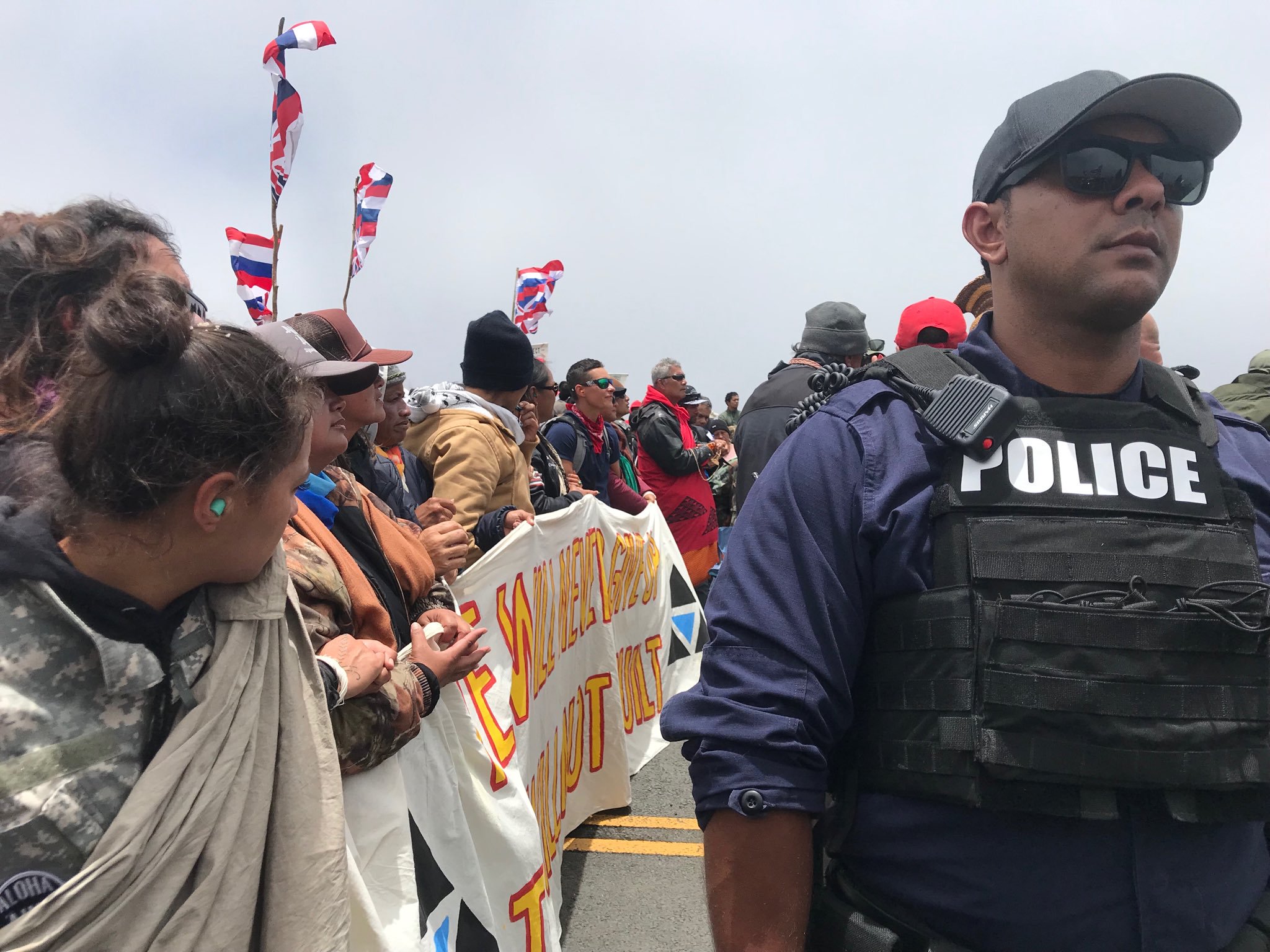
Kanaka Maoli, Native Hawaiians, are peacefully protesting the construction of a Thirty Meter Telescope on their sacred site, Mauna Kea. The project was scheduled to begin on July 15.
Nearly a thousand opponents closed off the only road that leads to the summit of their sacred site, Mauna Kea, over the weekend.
Thirty-three demonstrators, mostly elders, or kupuna, have been arrested by police because they were blocking the road.
On Wednesday, July 17th, a heavily armed police force arrested over 20 Native Hawaiian elders who were peacefully protecting Mauna Kea from desecration. #TMTShutdown #AoleTMT #KuKiaʻiMauna pic.twitter.com/igh2SFtjkm
— Mikeyoke (@karaokecomputer) July 18, 2019
Major action at #Maunakea access road. Kūpuna (elders) blocking road… People locked down. Protectors defending sacred mountain from construction of a Thirty Metre Telescope #TMT.
Police moving in… Photos by Andre Perez from Jul 15, 2019. pic.twitter.com/dlp1TP01Nw
— Emilee Gilpin (@emileegilpin) July 16, 2019
Governor of Hawai’i David Ige signed an emergency proclamation on Wednesday giving law enforcement the ability to close sections of the main road to access Mauna Kea.
Rep. Amy Perruso, D-Hawaii said the “declaration is disturbing.”
“By all accounts, the demonstrations on #MaunaKea have been peaceful. Here’s the real emergency: the state’s and UH’s failure in handling mauna lands,” she said.
Protestors are following a sacred mandate called kapu aloha in committing to non-violence. They ask people to “keep good energy,” by refraining from being too loud or belligerent. Other guidelines include no drugs and alcohol at the site, amongst other things.
Social media posts show protestors chain linking arms to create a barrier from law enforcement. Other videos show them chanting and singing in the Hawaiian language.
“We are genealogically connected to this mountain,” says Lanakila Managauil, 32, told Indian Country Today. “We refer to the mauna as a piko, which is a focal point of spiritual power.”
The telescope is proposed to be nearly 18-stories high and will cost $1.4 billion. It will sit next to 13 other astronomical observatories atop of the mountain if successfully constructed.
Katie Kamelamela said that much of the conflict is not just about Hawaiians versus science.
“The conflict on Mauna Kea is about the state breaking their own laws, protocols, and commitments such as providing ‘a Hawaiian place of learning’ at UH Manoa and upholding their fiduciary duty to protect Hawaiian rights,” she said.
For the record:
1. I am a Hawaiian scientist and there are more of us than you see/hear. We are not unicorns, we are human.
2. The conflict on Mauna Kea is NOT about Hawaiians vs. Science.1/x
— Katie L. Kamelamela (@kteabam) July 15, 2019
Many others have organized protests across the mainland and other Hawaiian islands, including highway shutdowns near Honolulu and an occupation at the governor’s office.
The TMT International Observatory LLC, a non-profit organization, selected Mauna Kea to be its building site in 2009 after developers concluded it had the best characteristics for “capturing images and producing the best science.” Their mission is to utilize the dormant volcano’s unique geographic positioning to study astronomy and present their findings to various academic institutions around the globe.
Indian Country Today reported that the telescope was approved to be built after a Hawai’i Supreme Court ruling in October. Additional opposition to the telescope has included a 10-year battle of public meetings, protests and presentations.
Members of the non-profit organization, which is managing the project, include various institutions including Caltech, the National Institutes of Natural Sciences in Japan, the National Research Council in Canada amongst others. They are funded through the Gordon & Betty Moore Foundation.
Kanaka Maoli are preparing to stay at the site for the long-run. “We are strongly and deeply committed,” Managauil says. “There’s only one Mauna Kea.”

Indigenous Peoples are putting their bodies on the line and it's our responsibility to make sure you know why. That takes time, expertise and resources - and we're up against a constant tide of misinformation and distorted coverage. By supporting IC you're empowering the kind of journalism we need, at the moment we need it most.